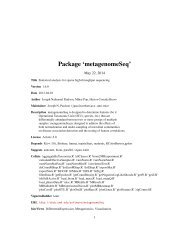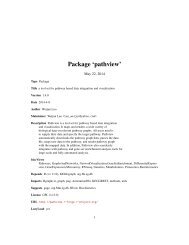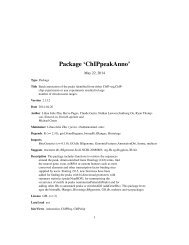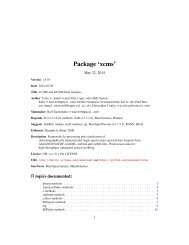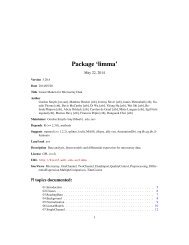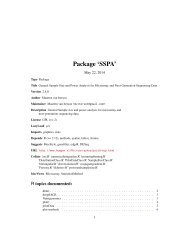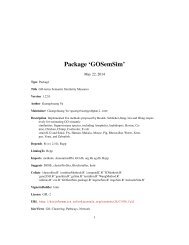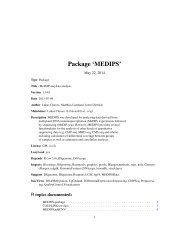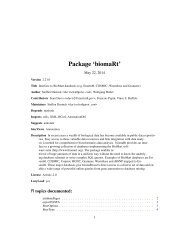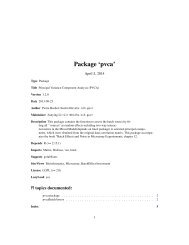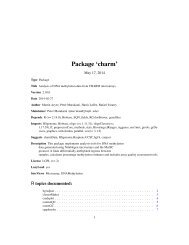Package 'KEGGgraph' - Bioconductor
Package 'KEGGgraph' - Bioconductor
Package 'KEGGgraph' - Bioconductor
Create successful ePaper yourself
Turn your PDF publications into a flip-book with our unique Google optimized e-Paper software.
<strong>Package</strong> ‘KEGGgraph’<br />
May 22, 2014<br />
Type <strong>Package</strong><br />
Title KEGGgraph: A graph approach to KEGG PATHWAY in R and <strong>Bioconductor</strong><br />
Version 1.22.1<br />
Date 2013-10-10<br />
Author Jitao David Zhang, with inputs from Paul Shannon<br />
Maintainer Jitao David Zhang <br />
Description KEGGGraph is an interface between KEGG pathway and graph<br />
object as well as a collection of tools to analyze, dissect and<br />
visualize these graphs. It parses the regularly updated KGML<br />
(KEGG XML) files into graph models maintaining all essential<br />
pathway attributes. The package offers functionalities<br />
including parsing, graph operation, visualization and etc.<br />
License GPL (>= 2)<br />
LazyLoad yes<br />
Depends R (>= 2.10), methods, XML (>= 2.3-0), graph<br />
Imports methods, XML, graph<br />
Suggests Rgraphviz, RBGL, RUnit, RColorBrewer, KEGG.db, org.Hs.eg.db,hgu133plus2.db, SPIA<br />
Collate kegg2graph-functions.R parse.R annotation.R graph.R kgmlfile.R misc.R vis.R<br />
URL http://www.nextbiomotif.com<br />
biocViews Pathways, GraphAndNetwork, Visualization<br />
1
2 R topics documented:<br />
R topics documented:<br />
expandKEGGNode . . . . . . . . . . . . . . . . . . . . . . . . . . . . . . . . . . . . . 3<br />
expandKEGGPathway . . . . . . . . . . . . . . . . . . . . . . . . . . . . . . . . . . . 3<br />
getDisplayName-methods . . . . . . . . . . . . . . . . . . . . . . . . . . . . . . . . . . 4<br />
getEntryID-methods . . . . . . . . . . . . . . . . . . . . . . . . . . . . . . . . . . . . 5<br />
getKEGGgeneLink-methods . . . . . . . . . . . . . . . . . . . . . . . . . . . . . . . . 6<br />
getKEGGID-methods . . . . . . . . . . . . . . . . . . . . . . . . . . . . . . . . . . . . 6<br />
getKEGGnodeData . . . . . . . . . . . . . . . . . . . . . . . . . . . . . . . . . . . . . 7<br />
getKGMLurl . . . . . . . . . . . . . . . . . . . . . . . . . . . . . . . . . . . . . . . . 8<br />
getName-methods . . . . . . . . . . . . . . . . . . . . . . . . . . . . . . . . . . . . . . 9<br />
getNamedElement . . . . . . . . . . . . . . . . . . . . . . . . . . . . . . . . . . . . . . 10<br />
getPathwayInfo-methods . . . . . . . . . . . . . . . . . . . . . . . . . . . . . . . . . . 11<br />
getReactions-methods . . . . . . . . . . . . . . . . . . . . . . . . . . . . . . . . . . . . 12<br />
getRgraphvizEdgeNames . . . . . . . . . . . . . . . . . . . . . . . . . . . . . . . . . . 13<br />
getSubtype-methods . . . . . . . . . . . . . . . . . . . . . . . . . . . . . . . . . . . . 13<br />
getTitle-methods . . . . . . . . . . . . . . . . . . . . . . . . . . . . . . . . . . . . . . 14<br />
getType-methods . . . . . . . . . . . . . . . . . . . . . . . . . . . . . . . . . . . . . . 15<br />
getValue-methods . . . . . . . . . . . . . . . . . . . . . . . . . . . . . . . . . . . . . . 16<br />
graphDensity . . . . . . . . . . . . . . . . . . . . . . . . . . . . . . . . . . . . . . . . 16<br />
isHomoList . . . . . . . . . . . . . . . . . . . . . . . . . . . . . . . . . . . . . . . . . 17<br />
KEGGEdge-class . . . . . . . . . . . . . . . . . . . . . . . . . . . . . . . . . . . . . . 18<br />
KEGGEdgeSubtype . . . . . . . . . . . . . . . . . . . . . . . . . . . . . . . . . . . . . 19<br />
KEGGEdgeSubType-class . . . . . . . . . . . . . . . . . . . . . . . . . . . . . . . . . 20<br />
KEGGGraphics-class . . . . . . . . . . . . . . . . . . . . . . . . . . . . . . . . . . . . 21<br />
KEGGGroup-class . . . . . . . . . . . . . . . . . . . . . . . . . . . . . . . . . . . . . 22<br />
KEGGNode-class . . . . . . . . . . . . . . . . . . . . . . . . . . . . . . . . . . . . . . 23<br />
KEGGPathway-class . . . . . . . . . . . . . . . . . . . . . . . . . . . . . . . . . . . . 24<br />
KEGGpathway2Graph . . . . . . . . . . . . . . . . . . . . . . . . . . . . . . . . . . . 25<br />
KEGGpathway2reactionGraph . . . . . . . . . . . . . . . . . . . . . . . . . . . . . . . 26<br />
KEGGPathwayInfo-class . . . . . . . . . . . . . . . . . . . . . . . . . . . . . . . . . . 28<br />
KEGGReaction-class . . . . . . . . . . . . . . . . . . . . . . . . . . . . . . . . . . . . 29<br />
kgmlFileName2PathwayName . . . . . . . . . . . . . . . . . . . . . . . . . . . . . . . 30<br />
mergeGraphs . . . . . . . . . . . . . . . . . . . . . . . . . . . . . . . . . . . . . . . . 31<br />
mergeKEGGgraphs . . . . . . . . . . . . . . . . . . . . . . . . . . . . . . . . . . . . . 32<br />
neighborhood . . . . . . . . . . . . . . . . . . . . . . . . . . . . . . . . . . . . . . . . 33<br />
parseEntry . . . . . . . . . . . . . . . . . . . . . . . . . . . . . . . . . . . . . . . . . . 34<br />
parseGraphics . . . . . . . . . . . . . . . . . . . . . . . . . . . . . . . . . . . . . . . . 35<br />
parseKGML . . . . . . . . . . . . . . . . . . . . . . . . . . . . . . . . . . . . . . . . . 36<br />
parseKGML2DataFrame . . . . . . . . . . . . . . . . . . . . . . . . . . . . . . . . . . 37<br />
parseKGML2Graph . . . . . . . . . . . . . . . . . . . . . . . . . . . . . . . . . . . . . 38<br />
parseKGMLexpandMaps . . . . . . . . . . . . . . . . . . . . . . . . . . . . . . . . . . 39<br />
parsePathwayInfo . . . . . . . . . . . . . . . . . . . . . . . . . . . . . . . . . . . . . . 40<br />
parseReaction . . . . . . . . . . . . . . . . . . . . . . . . . . . . . . . . . . . . . . . . 41<br />
parseRelation . . . . . . . . . . . . . . . . . . . . . . . . . . . . . . . . . . . . . . . . 41<br />
parseSubType . . . . . . . . . . . . . . . . . . . . . . . . . . . . . . . . . . . . . . . . 42<br />
plotKEGGgraph . . . . . . . . . . . . . . . . . . . . . . . . . . . . . . . . . . . . . . . 43<br />
pvalue2asterisk . . . . . . . . . . . . . . . . . . . . . . . . . . . . . . . . . . . . . . . 44
expandKEGGNode 3<br />
queryKEGGsubgraph . . . . . . . . . . . . . . . . . . . . . . . . . . . . . . . . . . . . 45<br />
randomSubGraph . . . . . . . . . . . . . . . . . . . . . . . . . . . . . . . . . . . . . . 46<br />
splitKEGGgroup . . . . . . . . . . . . . . . . . . . . . . . . . . . . . . . . . . . . . . 47<br />
subGraphByNodeType . . . . . . . . . . . . . . . . . . . . . . . . . . . . . . . . . . . 48<br />
subKEGGgraph . . . . . . . . . . . . . . . . . . . . . . . . . . . . . . . . . . . . . . . 48<br />
subtypeDisplay-methods . . . . . . . . . . . . . . . . . . . . . . . . . . . . . . . . . . 49<br />
top . . . . . . . . . . . . . . . . . . . . . . . . . . . . . . . . . . . . . . . . . . . . . . 50<br />
translateKEGGgraph . . . . . . . . . . . . . . . . . . . . . . . . . . . . . . . . . . . . 50<br />
translateKEGGID2GeneID . . . . . . . . . . . . . . . . . . . . . . . . . . . . . . . . . 51<br />
Index 53<br />
expandKEGGNode<br />
Expand KEGG node of paralogues<br />
Description<br />
Usage<br />
The function expands KEGG node of paralogues, and is mainly used internally. The end-users are<br />
not expected to call it unless they know exactly what they are doing.<br />
expandKEGGNode(node)<br />
Arguments<br />
node<br />
An object of KEGGNode-class<br />
Author(s)<br />
Jitao David Zhang mailto:jitao_david.zhang@roche.com<br />
expandKEGGPathway<br />
Expand KEGG Pathway<br />
Description<br />
Usage<br />
The function expands paralogue nodes in KEGG pathway and returns expanded KEGG pathway,<br />
KEGG node and edge data is maintained.<br />
expandKEGGPathway(pathway)<br />
Arguments<br />
pathway<br />
An object of KEGGPathway-class
4 getDisplayName-methods<br />
Details<br />
The function expands nodes with paralogues in KEGG pathway and copy neccessary edges.<br />
Value<br />
An object of KEGGPathway-class<br />
Author(s)<br />
Jitao David Zhang mailto:jitao_david.zhang@roche.com<br />
See Also<br />
expandKEGGNode<br />
Examples<br />
sfile
getEntryID-methods 5<br />
Examples<br />
sfile
6 getKEGGID-methods<br />
getKEGGgeneLink-methods<br />
Get KEGG gene link<br />
Description<br />
Tranlsate a object into a link point to the gene on KEGG website.<br />
This method complies with the Gene link rule of the KEGG website.<br />
Methods<br />
object = "character" A KEGGID, for example ’hsa:1423’<br />
Examples<br />
getKEGGgeneLink("hsa:1423")<br />
getKEGGID-methods<br />
Get KEGG ID<br />
Description<br />
Get KEGGID from a KEGGNode-class object.<br />
The KEGGNode-class can be either another pathway (KEGGID in the form like ’hsa\d*’), KEGG<br />
Gene (’hsa:\d*’) or compound (’cpd:C\d*’). In case of the KEGG Gene ID, the organism prefix is<br />
removed when the value is returned.<br />
Methods<br />
object = "KEGGNode" An object of KEGGNode-class<br />
Examples<br />
wntfile
getKEGGnodeData 7<br />
getKEGGnodeData<br />
Get or set list of KEGG node or edge data<br />
Description<br />
The ’get’ methods extracts KEGG node (edge) attributes from a graph produced by calling parseKGML2Graph<br />
or KEGGpathway2Graph. The ’set’ methods writes a list into the edge or node data.<br />
Usage<br />
getKEGGnodeData(graph, n)<br />
getKEGGedgeData(graph, n)<br />
Arguments<br />
graph<br />
n<br />
a graph object by parsing KGML file, where KEGG node and edge attributes<br />
are maintained<br />
optional character string, name of the desired node or edge. If is missing all<br />
node Data is returned<br />
Details<br />
Node and edge data is stored as list within environments in graphs to save memory and speed up<br />
graph manipulations. When using getKEGGnodeData or getKEGGedgeData is called, the list is<br />
extracted out of the environment and returned.<br />
Value<br />
Either a list or single item of KEGGNode-class or KEGGEdge-class object(s).<br />
Note<br />
These functions will be unified into ’KEGGnodeData’ and ’KEGGnodeData
8 getKGMLurl<br />
getKGMLurl<br />
Get KGML file (url) with KEGG PATHWAY ID and (optional) organism<br />
Description<br />
Usage<br />
The function simply returns the KGML file url given KEGG PATHWAY ID. If the KEGG PATH-<br />
WAY ID contains no organism prefix, user can specify the ’organism’ parameter. Otherwise the<br />
’organism’ option is ignored.<br />
retrieveKGML is a simple wrapper to getKGMLurl, which downloads the KGML file with download.file<br />
in utils package.<br />
getKGMLurl(pathwayid, organism = "hsa")<br />
retrieveKGML(pathwayid, organism, destfile,method="wget", ...)<br />
kgmlNonmetabolicName2MetabolicName(destfile)<br />
getCategoryIndepKGMLurl(pathwayid, organism="hsa", method="wget", ...)<br />
Arguments<br />
Details<br />
Value<br />
pathwayid<br />
organism<br />
destfile<br />
method<br />
KEGG PATHWAY ID, e.g. ’hsa00020’<br />
three-alphabet organism code, if pathwayid contains the ocde this option is ignored<br />
Destination file, to which the remote KGML file should be saved<br />
Method to be used for downloading files, passed to download.file function.<br />
Currently supports "internal", "wget" and "lynx"<br />
... Parameters passed to download.file<br />
The function getKGMLurl takes the pathway identifier (can be in the form of ’hsa00020’ or with<br />
’pathway’ prefix, for example ’path:hsa00020’), and returns the url to download KGML file.<br />
The mapping between pathway identifier and pathway name can be found by KEGGPATHNAME2ID<br />
(or reversed mappings) in KEGG.db package. See vignette for example.<br />
retrieveKGML calls download.file to download the KGML file from KEGG FTP remotely.<br />
Since July 2011 the KGML is downloaded directly from the HTTP main page of each pathway,<br />
instead of from the FTP server. The FTP server is only open to subscribers. Commercial and<br />
other users should consider support the KEGG database by subscribing to the FTP service. See the<br />
references section below.<br />
KGML File URL of the given pathway.
getName-methods 9<br />
Note<br />
So far the function does not check the correctness of the ’organism’ prefix, it is the responsibility of<br />
the user to garantee the right spelling.<br />
For Windows users, it is necessary to download and install wget program (http://gnuwin32.<br />
sourceforge.net/packages/wget.htm) to use the wget method to download files. Sometimes it<br />
may be necessary to modify searching path to add GnuWin32 folder (where wget execution file is<br />
located) and re-install R to make wget work.<br />
Some user may experience difficulty of retrieving KGML files when the download method is set<br />
to ‘auto’. In this case setting the method to ‘wget’ may solve the problem (thanks to the report by<br />
Gilbert Feng).<br />
There were a period when the metabolic and non-metabolic pathways were saved separately in different<br />
directories, and KEGGgraph was able to handle them. kgmlNonmetabolicName2MetabolicName<br />
is used to translate non-metabolic pathway KGML URL to that of metabolic pathway. getCategoryIndepKGMLurl<br />
determines the correct URL to download by attempting both possibilities. They were mainly called<br />
internally. Now since the KGML file is to be downloaded in each pathway’s main page instead from<br />
the FTp server, these functions are no more needed and will be removed in the next release.<br />
Author(s)<br />
Jitao David Zhang mailto:jitao_david.zhang@roche.com<br />
References<br />
Plea from KEGG (available as of Aug 2011) http://www.genome.jp/kegg/docs/plea.html<br />
Examples<br />
getKGMLurl("hsa00020")<br />
getKGMLurl("path:hsa00020")<br />
getKGMLurl("00020",organism="hsa")<br />
getKGMLurl(c("00460", "hsa:00461", "path:hsa00453", "path:00453"))<br />
## NOT RUN<br />
tmp
10 getNamedElement<br />
Methods<br />
object = "KEGGEdgeSubType" An object of KEGGEdgeSubType-class<br />
object = "KEGGNode" An object of KEGGNode-class<br />
object = "KEGGPathway" An object of KEGGPathway-class<br />
object = "KEGGPathwayInfo" An object of KEGGPathwayInfo-class<br />
object = "KEGGReaction" An object of KEGGReaction-class<br />
Author(s)<br />
Jitao David Zhang mailto:jitao_david.zhang@roche.com<br />
References<br />
KGML Document Manual http://www.genome.jp/kegg/docs/xml/<br />
Examples<br />
sfile
getPathwayInfo-methods 11<br />
Arguments<br />
vector<br />
name<br />
A named vector of any data type<br />
Wanted name<br />
Value<br />
The elements with the given name, ’NA’ in case no one was found<br />
Author(s)<br />
Jitao David Zhang mailto:jitao_david.zhang@roche.com<br />
Examples<br />
vec
12 getReactions-methods<br />
getReactions-methods<br />
Get KEGG reactions<br />
Description<br />
In KGML, the pathway element specifies one graph object with the entry elements as its nodes and<br />
the relation and reaction elements as its edges. The relation elements are saved as edges in objects<br />
of KEGGPathway-class, and the reactions elements are saved as a slot of the object, which can be<br />
retrieved with the function getReactions.<br />
Regulatory pathways are always viewed as protein networks, so there is no ’reaction’ information<br />
saved in their KGML files. Metabolic pathways are viewed both as both protein networks and<br />
chemical networks, hence the KEGGPathway-class object may have reactions information.<br />
Methods<br />
object = "KEGGPathway" An object of KEGGPathway-class<br />
Author(s)<br />
Jitao David Zhang mailto:jitao_david.zhang@roche.com<br />
References<br />
KGML Document manual http://www.genome.jp/kegg/docs/xml/<br />
See Also<br />
KEGGPathway-class<br />
Examples<br />
mapfile
getRgraphvizEdgeNames 13<br />
getRgraphvizEdgeNames<br />
Get Rgraphviz compatitable edge names<br />
Description<br />
Usage<br />
Get Rgraphviz compatitable edge names, where the out- and in-nodes sharing a edge are concatenated<br />
by "~".<br />
getRgraphvizEdgeNames(graph)<br />
Arguments<br />
graph<br />
A graph object<br />
Value<br />
A list of names, the order is determined by the edge order.<br />
Author(s)<br />
Jitao David Zhang maito:jitao_david.zhang@roche.com<br />
References<br />
Rgraphviz package<br />
Examples<br />
tnodes
14 getTitle-methods<br />
Methods<br />
object = "graph" A graph object of KEGGgraph. The method returns a list of subtypes in the<br />
same order of edges<br />
object = "KEGGEdge" An object of KEGGEdge, which stores the subtype information<br />
Author(s)<br />
Jitao David Zhang mailto:jitao_david.zhang@roche.com<br />
References<br />
KGML Document manual http://www.genome.jp/kegg/docs/xml/<br />
Examples<br />
sfile
getType-methods 15<br />
Examples<br />
sfile
16 graphDensity<br />
getValue-methods<br />
Get ’value’ attribute<br />
Description<br />
Get ’value’ attribute, mainly used internally and is not expected to be called by users.<br />
Methods<br />
object = "KEGGEdgeSubType" An object of KEGGEdgeSubType-class<br />
graphDensity<br />
Graph density<br />
Description<br />
The graph density is defined as d = E/(V*(V-1)/2) where E is the number of edges and V of nodes.<br />
Usage<br />
graphDensity(graph)<br />
Arguments<br />
graph<br />
A graph object<br />
Details<br />
The density of a graph lies between [0,1]<br />
Value<br />
A value between [0,1]<br />
Author(s)<br />
Jitao David Zhang jitao_david.zhang@roche.com<br />
References<br />
Aittokallio and Schwikowski (2006), Graph-based methods for analysing networks in cell biology,<br />
Briefings in Bioinformatics, 7, 243-255.
isHomoList 17<br />
Examples<br />
tnodes
18 KEGGEdge-class<br />
KEGGEdge-class<br />
Class ’KEGGEdge’<br />
Description<br />
A class to represent ’relation’ elements in KGML files and edge objects in a KEGG graph<br />
Objects from the Class<br />
Objects are normally created by parseRelation function, which is not intended to be called by<br />
user directly<br />
Slots<br />
entry1ID: The entryID of the first KEGGNode<br />
entry2ID: The entryID of the second KEGGNode<br />
type: The type of the relation, see getType-methods<br />
subtype: The subtype(s) of the edge, a list of KEGGEdgeSubType<br />
Methods<br />
getEntryID signature(obj = "KEGGEdge"): Get entryIDs of the edge in the order specified by<br />
the direction of the edge<br />
getType signature(object = "KEGGEdge"): Get the relation type<br />
getName signature(object = "KEGGEdge"): Get the names of edges in the convention of<br />
Rgraphviz, ’node1~node2’<br />
show signature(object = "KEGGEdge"): Show method<br />
Author(s)<br />
Jitao David Zhang mailto:jitao_david.zhang@roche.com<br />
References<br />
KGML Manual http://www.genome.jp/kegg/docs/xml/<br />
See Also<br />
KEGGNode-class
KEGGEdgeSubtype 19<br />
Examples<br />
mapfile
20 KEGGEdgeSubType-class<br />
KEGGEdgeSubType-class<br />
Class "KEGGEdgeSubType"<br />
Description<br />
A class to represent subtype in KEGG<br />
Objects from the Class<br />
Objects can be created by calls of the form new("KEGGEdgeSubType", ...).<br />
Slots<br />
name: Object of class "character", name of the subtype<br />
value: Object of class "character", value of the subtype<br />
Methods<br />
getName signature(object = "KEGGEdgeSubType"): getting subtype name<br />
getValue signature(object = "KEGGEdgeSubType"): getting subtype value<br />
show signature(object = "KEGGEdgeSubType"): show method<br />
Note<br />
Please note that ’KEGGEdgeSubtype’ is a data frame storing subtype predefinitions, the ’type’ with<br />
lowercases. ’KEGGEdgeSubType’ is however a class representing these subtypes.<br />
Author(s)<br />
Jitao David Zhang mailto:jitao_david.zhang@roche.com<br />
See Also<br />
KEGGEdge-class<br />
Examples<br />
showClass("KEGGEdgeSubType")<br />
## use example(KEGGEdge-class) for more examples
KEGGGraphics-class 21<br />
KEGGGraphics-class<br />
class ’KEGGGraphics’<br />
Description<br />
A class to represent ’graphics’ element in KGML files<br />
Objects from the Class<br />
This method is mainly used to extract visualization information from KGML files.<br />
Objects can be created by calling parseGraphics<br />
Slots<br />
name: Object of class "character" graphics name<br />
x: Object of class "integer" x coordinate in KEGG figure<br />
y: Object of class "integer" y coordinate in KEGG figure<br />
type: Object of class "character" graphics type (shape)<br />
width: Object of class "integer" witdh of the symbol<br />
height: Object of class "integer" height of the symbol<br />
fgcolor: Object of class "character" foreground color<br />
bgcolor: Object of class "character" background color<br />
Author(s)<br />
Jitao David Zhang mailto:jitao_david.zhang@roche.com<br />
References<br />
KGML Manual http://www.genome.jp/kegg/docs/xml/<br />
See Also<br />
parseGraphics<br />
Examples<br />
showClass("KEGGGraphics")
22 KEGGGroup-class<br />
KEGGGroup-class<br />
Class "KEGGGroup"<br />
Description<br />
Class to represent ’group’ nodes in KEGG pathways<br />
Objects from the Class<br />
The objects are usually created by parseEntry function and is not intended to be called directly by<br />
users.<br />
Slots<br />
component: Component of the group<br />
entryID: see the slot of KEGGNode-class<br />
graphics: see the slot of KEGGNode-class<br />
link: see the slot of KEGGNode-class<br />
map: see the slot of KEGGNode-class<br />
name: see the slot of KEGGNode-class<br />
reaction: see the slot of KEGGNode-class<br />
type: see the slot of KEGGNode-class<br />
Extends<br />
Class "KEGGNode", directly.<br />
Methods<br />
getComponent signature(object = "KEGGNode"): returns components of the group, in a vector<br />
of strings<br />
Author(s)<br />
Jitao David Zhang mailto:jitao_david.zhang@roche.com<br />
See Also<br />
KEGGNode-class<br />
Examples<br />
showClass("KEGGGroup")
KEGGNode-class 23<br />
KEGGNode-class<br />
Class "KEGGNode"<br />
Description<br />
The class to present ’entry’ element in KGML files and nodes in KEGG graphs<br />
Objects from the Class<br />
Slots<br />
Objects can be created by calls of the function parseEntry and is not intended to be directly created<br />
by users.<br />
entryID: entryID, the ’id’ attribute of ’entry’ elements in KGML files. In each KGML file the entryID<br />
is specified by auto-increment integers, therefore entryIDs from two individual KGML<br />
files are not unique. However, if ’expandGenes’ option is specified in KEGGpathway2Graph<br />
function, the unique KEGGID will replace the default integer as the new entryID, which is<br />
unique in biological context<br />
name: Name of the node<br />
type: Type of the node, use data(KEGGNodeType) to see available values<br />
link: URL link of the node<br />
reaction: Reaction of the node<br />
map: Map of the node<br />
graphics: Graphic details (including display name) of the node, an object of KEGGGraphics<br />
Methods<br />
getDisplayName signature(object = "KEGGNode"): get display name<br />
getEntryID signature(obj = "KEGGNode"): get entryID, in case of gene-expanded graphs this<br />
is the same as getKEGGID<br />
getKEGGID signature(object = "KEGGNode"): get KEGGID<br />
getType signature(object = "KEGGNode"): get the type of the node<br />
24 KEGGPathway-class<br />
See Also<br />
KEGGEdge-class, parseEntry<br />
Examples<br />
## We show how to extract information from KEGGNode object<br />
sfile
KEGGpathway2Graph 25<br />
getPathwayInfo signature(object = "KEGGPathway"): getting KEGGPathwayInfo<br />
getTitle signature(object = "KEGGPathway"): getting title of the pathway<br />
show signature(object = "KEGGPathway"): display method<br />
Author(s)<br />
Jitao David Zhang mailto:jitao_david.zhang@roche.com<br />
References<br />
KGML Document manual http://www.genome.jp/kegg/docs/xml/<br />
See Also<br />
parseKGML, KEGGEdge-class, KEGGNode-class, KEGGReaction-class<br />
Examples<br />
## We show how to extract information from KEGGPathway objects<br />
## Parse KGML file into a KEGGPathway object<br />
mapfile
26 KEGGpathway2reactionGraph<br />
Usage<br />
KEGGpathway2Graph(pathway, genesOnly = TRUE, expandGenes = TRUE)<br />
Arguments<br />
pathway<br />
genesOnly<br />
expandGenes<br />
An instance of KEGGPathway-class<br />
logical, should only the genes are maintained and other types of nodes (compounds,<br />
etc) neglected TRUE by default<br />
logical, should homologue proteins expanded TRUE by default<br />
Details<br />
When ’expandGenes=TRUE’, the nodes have unique names of KEGGID (in the form of ’org:xxxx’,<br />
for example ’hsa:1432’), otherwise an auto-increment index given by KEGG is used as node names.<br />
In the latter case, the node names are duplicated and graphs cannot be simply merged before the<br />
nodes are unique.<br />
KEGG node and edge data is stored in ’nodeData’ and ’edgeData’ slots respectively, which can be<br />
extracted by getKEGGnodeData and getKEGGedgeData.<br />
Value<br />
A directed graph.<br />
Author(s)<br />
Jitao David Zhang mailto:jitao_david.zhang@roche.com<br />
See Also<br />
parseKGML2Graph<br />
Examples<br />
sfile
KEGGpathway2reactionGraph 27<br />
Description<br />
Regulatory pathways are always viewed as protein networks, so there is no ’reaction’ information<br />
saved in their KGML files. Metabolic pathways are viewed both as both protein networks and<br />
chemical networks, hence the KEGGPathway-class object may have reactions information among<br />
chemical compounds.<br />
This functions extracts reaction information from KEGG pathway, and convert the chemical compound<br />
reaction network into directed graph.<br />
Usage<br />
KEGGpathway2reactionGraph(pathway)<br />
Arguments<br />
pathway<br />
A KEGGPathway-class object, usually as the result of the function parseKGML<br />
Details<br />
The direction of the graph is specified by the role of the compound in the reaction, the edges goes<br />
always out of ’substrate’ and points to ’product’.<br />
For now there is no wrapper to parse the KGML file directly into a reaction graph. In future there<br />
maybe one, but we don’t want to confuse users with two similar functions to parse the file into a<br />
graph (since we assume that most users will need the protein graph, which can be conveniently<br />
parsed by parseKGML2Graph).<br />
From version 1.18.0, reaction graphs returned by KEGGpathway2reactionGraph can be merged<br />
with other reaction graphs or pathway graphs.Thus users can combine pathway and reaction graph<br />
in one KGML file into a single graph.<br />
Value<br />
A directed graph with compounds as nodes and reactions as edges.<br />
If the pathway does not contain any chemical reactions, a warning message will be printed and NULL<br />
is returned.<br />
Author(s)<br />
Jitao David Zhang mailto:jitao_david.zhang@roche.com<br />
References<br />
KGML Document manual http://www.genome.jp/kegg/docs/xml/<br />
See Also<br />
KEGGPathway-class
28 KEGGPathwayInfo-class<br />
Examples<br />
mapfile
KEGGReaction-class 29<br />
Examples<br />
sfile
30 kgmlFileName2PathwayName<br />
Examples<br />
## We show how to extract reactions from a KEGGPathway object<br />
mapfile
mergeGraphs 31<br />
mergeGraphs<br />
A function to merge KEGG graphs<br />
Description<br />
The function merges a list of KEGG graphs into one graph object. The merged graph have unique<br />
nodes, and edges are merged into non-duplicate sets.<br />
For the reason of speed, mergeGraphs discards KEGG node and edge informations. To maintain<br />
them while merging graphs, please use mergeKEGGgraphs.<br />
Usage<br />
mergeGraphs(list, edgemode = "directed")<br />
Arguments<br />
list<br />
edgemode<br />
A list of graph objects, which can be created by parseKGML2Graph<br />
Edge mode of the graph product, by default ’directed’<br />
Details<br />
The function takes a list of graphs and merges them into a new graph. The nodes of individual<br />
graphs must be unique. The function takes care of the removal of duplicated edges.<br />
Value<br />
A directed graph<br />
Note<br />
It is known that graphs from C.elegance pathways have problem when merging, because the nodes<br />
name are not consistent betweeen edge records and entry IDs.<br />
Author(s)<br />
Jitao David Zhang <br />
See Also<br />
parseKGML2Graph
32 mergeKEGGgraphs<br />
mergeKEGGgraphs<br />
Merge KEGG graphs, also merging KEGGNode and KEGGEdge attributes<br />
Description<br />
mergeKEGGgraphs extends function mergeGraphs and merges a list of KEGG graphs. Both mergeGraphs<br />
and mergeKEGGgraphs can be used to merge graphs, while the latter form is able to merge the nodes<br />
and edges attributes from KEGG, so that the nodes and edges have a one-to-one mapping to the results<br />
from getKEGGnodeData and getKEGGEdgeData.<br />
See details below.<br />
Usage<br />
mergeKEGGgraphs(list, edgemode = "directed")<br />
Arguments<br />
list<br />
edgemode<br />
A list of named KEGG graphs<br />
character, ’directed’ by default<br />
Details<br />
mergeGraphs discards the node or edge attributes, hence getKEGGnodeData or getKEGGedgeData<br />
will return NULL on the resulting graph.<br />
mergeKEGGgraphs calls mergeGraphs first to merge the graphs, then it also merges the KEGGnode-<br />
Data and KEGGedgeData.so that they are one-to-one mapped to the nodes and edges in the merged<br />
graph.<br />
Value<br />
A graph with nodeData and edgeData<br />
Note<br />
From version 1.21.1, lists containing NULL should also work.<br />
Author(s)<br />
Jitao David Zhang mailto:jitao_david.zhang@roche.com<br />
See Also<br />
mergeGraphs
neighborhood 33<br />
Examples<br />
sfile
34 parseEntry<br />
Author(s)<br />
Jitao David Zhang <br />
References<br />
D.B. West. Introduction to Graph Theory, Second Edition. Prentice Hall, 2001<br />
Examples<br />
V
parseGraphics 35<br />
Details<br />
See http://www.genome.jp/kegg/docs/xml/ for more details about ’entry’ as well as other elements<br />
in KGML files.<br />
Value<br />
An object of link{KEGGNode} or (in case of a group node) link{KEGGGroup}<br />
Author(s)<br />
Jitao David Zhang <br />
References<br />
http://www.genome.jp/kegg/docs/xml/<br />
See Also<br />
parseGraphics, parseKGML, KEGGNode-class, KEGGGroup-class<br />
parseGraphics<br />
Parse ’graphics’ elements in KGML files<br />
Description<br />
The function parses ’graphics’ elements in KGML files, and it is mainly used internally.<br />
Usage<br />
parseGraphics(graphics)<br />
Arguments<br />
graphics<br />
XML node<br />
Details<br />
The function is called by other parsing functions and not intended to be called directly by user.<br />
Value<br />
An object of KEGGGraphics-class.<br />
Author(s)<br />
Jitao David Zhang mailto:jitao_david.zhang@roche.com
36 parseKGML<br />
References<br />
KGML Document manual http://www.genome.jp/kegg/docs/xml/<br />
See Also<br />
KEGGGraphics-class<br />
parseKGML<br />
KGML file parser<br />
Description<br />
The function parses KGML files according to the KGML XML documentation.<br />
Usage<br />
parseKGML(file)<br />
Arguments<br />
file<br />
Name of KGML file<br />
Details<br />
Value<br />
The function parses KGML file (depending on XML package).<br />
An object of KEGGPathway-class.<br />
Author(s)<br />
Jitao David Zhang mailto:jitao_david.zhang@roche.com<br />
References<br />
See Also<br />
KGML Manual http://www.genome.jp/kegg/docs/xml/<br />
parseEntry, parseRelation, parseReaction, KEGGPathway-class,<br />
Examples<br />
sfile
parseKGML2DataFrame 37<br />
parseKGML2DataFrame<br />
Parse KGML file into a data frame<br />
Description<br />
This function extends the parseKGML2Graph function, by converting the resulting graph into a threecolumn<br />
data frame representing out-nodes (the from column in the data frame), in-nodes (to) and<br />
subtypes of edges that connect them (subtype). It can be used, for example, for exporting KEGG<br />
pathway networks in plain text files.<br />
Usage<br />
parseKGML2DataFrame(file, reactions=FALSE,...)<br />
Arguments<br />
file<br />
reactions<br />
A KGML file<br />
Logical, whether metabolic reactions should be parsed and returned as part of<br />
the data frame. Default:FALSE<br />
... Other parameters passed to KEGGpathway2Graph<br />
Details<br />
The out- and in-nodes are represented in the form of KEGG identifiers. For human EntrezIDs the<br />
function translateKEGGID2GeneID can be used.<br />
Multile edges are supported: in case more than one subtypes of edges exist between two nodes, they<br />
are all listed in the resulting data frame.<br />
Value<br />
A three-column data frame, representing the graph structure: out-nodes (the from column), in-nodes<br />
(to) and edge subtype (subtype).<br />
Author(s)<br />
Jitao David Zhang<br />
See Also<br />
parseKGML2Graph, KEGGpathway2Graph and translateKEGGID2GeneID.
38 parseKGML2Graph<br />
Examples<br />
sfile
parseKGMLexpandMaps 39<br />
Examples<br />
sfile
40 parsePathwayInfo<br />
Author(s)<br />
Jitao David Zhang jitao_david.zhang@roche.com<br />
References<br />
KGML Document manual http://www.genome.jp/kegg/docs/xml/<br />
See Also<br />
for most users it is enough to use parseKGML2Graph<br />
parsePathwayInfo<br />
Parse information of the pathway from KGML files<br />
Description<br />
The function parses the information of the given pathway from KGML files into an object of<br />
KEGGPathwayInfo-class. It is used internally and is not expected to be called by users directly.<br />
Usage<br />
parsePathwayInfo(root)<br />
Arguments<br />
root<br />
Root element of the KGML file<br />
Value<br />
An object of KEGGPathwayInfo-class<br />
Author(s)<br />
Jitao David Zhang mailto:jitao_david.zhang@roche.com<br />
References<br />
KGML Document Manual http://www.genome.jp/kegg/docs/xml/
parseReaction 41<br />
parseReaction<br />
Parse reaction from KGML files<br />
Description<br />
The function parses ’reaction’ element in KGML files. It is used interally and not expected to be<br />
called by users.<br />
Usage<br />
parseReaction(reaction)<br />
Arguments<br />
reaction<br />
A node of the type ’reaction’ in KGML files<br />
Details<br />
See the reference manual for more information about ’reaction’ type<br />
Value<br />
An object of KEGGReaction-class<br />
Author(s)<br />
Jitao David Zhang mail:jitao_david.zhang@roche.com<br />
References<br />
KGML Document Manual http://www.genome.jp/kegg/docs/xml/<br />
parseRelation<br />
Parse RELATION elements from KGML files<br />
Description<br />
RELATION elements in KGML files record the binary relationships between ENTRY elements,<br />
corresponding to (directed) edges in a graph. ’parseRelation’ function parses RELATION elements<br />
into KEGGEdge-class objects from KGML files. It is not expected to be called directly by the user.<br />
Usage<br />
parseRelation(relation)
42 parseSubType<br />
Arguments<br />
relation<br />
XML node of KGML file<br />
Details<br />
Value<br />
See http://www.genome.jp/kegg/docs/xml/ for more details about ’relation’ as well as other<br />
elements in KGML files.<br />
An object of link{KEGGEdge}.<br />
Author(s)<br />
Jitao David Zhang <br />
References<br />
See Also<br />
http://www.genome.jp/kegg/docs/xml/<br />
KEGGEdge-class, parseEntry<br />
parseSubType<br />
Parse KGML relation subtype<br />
Description<br />
Usage<br />
The function parses KGML relation subtype, called internally and not intended to be used by end<br />
users.<br />
parseSubType(subtype)<br />
Arguments<br />
subtype<br />
KGML subtype node<br />
Value<br />
An object of KEGGEdgeSubType-class<br />
Author(s)<br />
Jitao David Zhang mailto:jitao_david.zhang@roche.com
plotKEGGgraph 43<br />
plotKEGGgraph<br />
Plot KEGG graph with Rgraphviz<br />
Description<br />
Usage<br />
The function provides a simple interface to Rgraphviz to render KEGG graph with custom styles.<br />
KEGGgraphLegend gives the legend of KEGG graphs<br />
plotKEGGgraph(graph, y = "neato", shortLabel = TRUE,<br />
useDisplayName=TRUE, nodeRenderInfos, ...)<br />
KEGGgraphLegend()<br />
Arguments<br />
graph<br />
y<br />
Details<br />
Value<br />
shortLabel<br />
A KEGG graph, by calling parseKGML2Graph<br />
the layout method, neato by default<br />
logical, should be short label used instead of full node name<br />
useDisplayName logical, should the labels of nodes rendered as the ’display name’ specified in<br />
the KGML file or render them simply with the node names<br />
nodeRenderInfos<br />
List of node rendering info<br />
... Other functions passed to renderGraph, not implemented for now<br />
Users are not restricted to this function, alternatively you can choose other rendering functions.<br />
The graph after layout and rendering is returned.<br />
Author(s)<br />
Jitao David Zhang mailto:jitao_david.zhang@roche.com<br />
Examples<br />
opar
44 pvalue2asterisk<br />
KEGGgraphLegend()<br />
par(opar)<br />
pvalue2asterisk<br />
Return common significance sign (asterisk) associated with given p<br />
value<br />
Description<br />
A p-value of 0.05, 0.01, 0.001 correspond to one, two or three asterisks. If ’sig.1’ is set to TRUE,<br />
then the p-value of 0.1 returns ’.’.<br />
Usage<br />
pvalue2asterisk(pvalues, sig.1 = FALSE)<br />
Arguments<br />
pvalues<br />
sig.1<br />
A numeric value<br />
logical, whether the significance sign of 0.1 should be returned<br />
Value<br />
A character string containing the signs<br />
Author(s)<br />
Jitao David Zhang mailto:jitao_david.zhang@roche.com<br />
Examples<br />
pvalue2asterisk(0.03)<br />
pvalue2asterisk(0.007)<br />
pvalue2asterisk(3e-5)<br />
pvalue2asterisk(0.55)
queryKEGGsubgraph 45<br />
queryKEGGsubgraph<br />
Query the subgraph of a given KEGG graph with Entrez GeneID (s)<br />
Description<br />
Given a list of genes (identified by Entrez GeneID), the function subsets the given KEGG gragh of<br />
the genes as nodes (and maintaining all the edges between).<br />
Usage<br />
queryKEGGsubgraph(geneids, graph, organism = "hsa", addmissing = FALSE)<br />
Arguments<br />
geneids<br />
graph<br />
organism<br />
addmissing<br />
A vector of Entrez GeneIDs<br />
A KEGG graph<br />
a three-alphabet code of organism<br />
logical, in case the given gene is not found in the graph, should it be added as<br />
single node to the subgraph<br />
Details<br />
This function solves the questions like ’How is the list of gene interact with each other in the context<br />
of pathways’<br />
Limited by the translateKEGGID2GeneID, this function supports only human for now. We are<br />
working to include other organisms.<br />
If ’addmissing’ is set to TRUE, the missing gene in the given list will be added to the returned<br />
subgraph as single nodes.<br />
Value<br />
A subgraph with nodes representing genes and edges representing interactions.<br />
Author(s)<br />
Jitao David Zhang <br />
See Also<br />
translateGeneID2KEGGID
46 randomSubGraph<br />
Examples<br />
sfile
splitKEGGgroup 47<br />
splitKEGGgroup<br />
Split KEGG group<br />
Description<br />
The function split ’group’ entries in KGML files. Most of the cases they are complexes. During the<br />
splitting the function copies the edges between groups and nodes (or between groups and groups)<br />
correspondingly, so that the existing edges also exist after the groups are split.<br />
Usage<br />
splitKEGGgroup(pathway)<br />
Arguments<br />
pathway<br />
An object of KEGGPathway-class<br />
Details<br />
By default the groups (complexes) in KEGG pathways are split.<br />
Value<br />
An object of KEGGPathway-class<br />
Author(s)<br />
Jitao David Zhang mailto:jitao_david.zhang@roche.com<br />
References<br />
KGML Manual http://www.genome.jp/kegg/docs/xml/<br />
See Also<br />
KEGGpathway2Graph<br />
Examples<br />
sfile
48 subKEGGgraph<br />
subGraphByNodeType<br />
Subset KEGG graph by node types<br />
Description<br />
The function subsets KEGG graph by node types, mostly used in extracting gene networks.<br />
Usage<br />
subGraphByNodeType(graph, type = "gene", kegg=TRUE)<br />
Arguments<br />
graph<br />
type<br />
kegg<br />
A KEGG graph object produced by calling parseKGML2Graph<br />
node type, see KEGGNodeType for details<br />
logical, should the KEGG Node and Edge attributes be maintained during the<br />
subsetting By default set to ’TRUE’<br />
Value<br />
A subgraph of the original graph<br />
Author(s)<br />
Jitao David Zhang mailto:jitao_david.zhang@roche.com<br />
Examples<br />
sfile
subtypeDisplay-methods 49<br />
Arguments<br />
nodes<br />
graph<br />
Node names to subset<br />
A graph parsed from KGML files, produced by parseKGML2Graph, KEGGpathway2Graph<br />
or parseKGMLexpandMaps<br />
Details<br />
Value<br />
subGraph does not subset the node or edge attributes, hence the results of getKEGGnodeData and<br />
getKEGGedgeData does not map to the nodes and edges in the subgraph in a one-to-one manner,<br />
with attributes of removed nodes and edges still remaining in the subGraph.<br />
subKEGGgraph calls subGraph first to subset the graph, and then it also subsets the KEGGnodeData<br />
and KEGGedgeData so that they are one-to-one mapped to the nodes and edges in the subgraph.<br />
A graph with nodeData and edgeData.<br />
Author(s)<br />
Jitao David Zhang mailto:jitao_david.zhang@roche.com<br />
Examples<br />
sfile
50 translateKEGGgraph<br />
top<br />
Colorectal cancer dataset<br />
Description<br />
Usage<br />
Colorectal cancer dataset provided by SPIA package. It is just a copy during the development of<br />
SPIA package in case the package is not available. It will be removed when the SPIA package is<br />
stable.<br />
see the description of SPIA package.<br />
data(colorectalcancerSPIA)<br />
Format<br />
see the format of SPIA package.<br />
Source<br />
Yi Hong and Kok Sun Ho and Kong Weng Eu and Peh Yean Cheah, A susceptibility gene set for<br />
early onset colorectal cancer that integrates diverse signaling pathways: implication for tumorigenesis,<br />
Clin Cancer Res, 2007, 13(4),1107-14.<br />
translateKEGGgraph<br />
Tranlate the KEGG graph from being indexed by KEGGID to another<br />
identifer<br />
Description<br />
The function translates the KEGG graph into a graph of equivalant topology while index with<br />
unique identifiers given by user. The new identifiers could be, for example, GeneSymbol or other<br />
identifiers mapped to KEGGID.<br />
Usage<br />
translateKEGGgraph(graph, newNodes)<br />
Arguments<br />
graph<br />
newNodes<br />
A KEGG graph<br />
A character vector giving the new nodes, must be of the same length and same<br />
order of the nodes of the given graph
translateKEGGID2GeneID 51<br />
Details<br />
The function is still experimental and users are welcomed to report any difficulties<br />
Value<br />
Another graph indexed by the given identifier<br />
Author(s)<br />
Jitao David Zhang <br />
Examples<br />
sfile
52 translateKEGGID2GeneID<br />
Details<br />
Value<br />
Note<br />
The KEGGID are unique identifiers used by KEGG PATHWAY to identify gene products. After<br />
parsing the KEGG pathway into graph, the graph use KEGGID as its nodes’ names.<br />
translateKEGGID2GeneID converts KEGGIDs into entrez GeneID, which can be translated to<br />
other types of identifiers, for example with biomaRt package or organism-specific annotation packages.<br />
See vignette for examples.<br />
translateKEGG2GeneID is maintained for back-compatibility and wrapps translateKEGGID2GeneID.<br />
Entrez GeneID of the given KEGG ID(s)<br />
This function works so far only with human KEGGIDs, since for them the Entrez GeneID can be<br />
derived easily with removing the organism prefix.<br />
The complete functional function will be implemented in the later release of the package.<br />
Author(s)<br />
Jitao David Zhang<br />
Examples<br />
egNodes
Index<br />
∗Topic IO<br />
getKGMLurl, 8<br />
parseEntry, 34<br />
parsePathwayInfo, 40<br />
parseReaction, 41<br />
parseRelation, 41<br />
∗Topic classes<br />
KEGGEdge-class, 18<br />
KEGGEdgeSubType-class, 20<br />
KEGGGraphics-class, 21<br />
KEGGGroup-class, 22<br />
KEGGNode-class, 23<br />
KEGGPathway-class, 24<br />
KEGGPathwayInfo-class, 28<br />
KEGGReaction-class, 29<br />
∗Topic datasets<br />
KEGGEdgeSubtype, 19<br />
top, 50<br />
∗Topic methods<br />
getDisplayName-methods, 4<br />
getEntryID-methods, 5<br />
getKEGGgeneLink-methods, 6<br />
getKEGGID-methods, 6<br />
getName-methods, 9<br />
getPathwayInfo-methods, 11<br />
getReactions-methods, 12<br />
getSubtype-methods, 13<br />
getTitle-methods, 14<br />
getType-methods, 15<br />
getValue-methods, 16<br />
subtypeDisplay-methods, 49<br />
download.file, 39<br />
edges,KEGGPathway,ANY-method<br />
(KEGGPathway-class), 24<br />
edges,KEGGPathway-method<br />
(KEGGPathway-class), 24<br />
edges
54 INDEX<br />
getKEGGID,KEGGNode-method<br />
(getKEGGID-methods), 6<br />
getKEGGID-methods, 6<br />
getKEGGnodeData, 7, 26, 32, 49<br />
getKGMLurl, 8<br />
getName (getName-methods), 9<br />
getName,KEGGEdge-method<br />
(KEGGEdge-class), 18<br />
getName,KEGGEdgeSubType-method<br />
(KEGGEdgeSubType-class), 20<br />
getName,KEGGEdgeSubtype-method<br />
(getName-methods), 9<br />
getName,KEGGNode-method<br />
(getName-methods), 9<br />
getName,KEGGPathway-method<br />
(KEGGPathway-class), 24<br />
getName,KEGGPathwayInfo-method<br />
(getName-methods), 9<br />
getName,KEGGReaction-method<br />
(KEGGReaction-class), 29<br />
getName-methods, 9<br />
getNamedElement, 10<br />
getPathwayInfo<br />
(getPathwayInfo-methods), 11<br />
getPathwayInfo,KEGGPathway-method<br />
(getPathwayInfo-methods), 11<br />
getPathwayInfo-methods, 11<br />
getProduct (KEGGReaction-class), 29<br />
getProduct,KEGGReaction-method<br />
(KEGGReaction-class), 29<br />
getReactions (getReactions-methods), 12<br />
getReactions,KEGGPathway-method<br />
(getReactions-methods), 12<br />
getReactions-methods, 12<br />
getRgraphvizEdgeNames, 13<br />
getSubstrate (KEGGReaction-class), 29<br />
getSubstrate,KEGGReaction-method<br />
(KEGGReaction-class), 29<br />
getSubtype (getSubtype-methods), 13<br />
getSubtype,graph-method<br />
(getSubtype-methods), 13<br />
getSubtype,KEGGEdge-method<br />
(getSubtype-methods), 13<br />
getSubtype-methods, 13<br />
getTitle (getTitle-methods), 14<br />
getTitle,KEGGPathway-method<br />
(KEGGPathway-class), 24<br />
getTitle,KEGGPathwayInfo-method<br />
(KEGGPathwayInfo-class), 28<br />
getTitle-methods, 14<br />
getType (getType-methods), 15<br />
getType,KEGGEdge-method<br />
(getType-methods), 15<br />
getType,KEGGNode-method<br />
(getType-methods), 15<br />
getType,KEGGReaction-method<br />
(getType-methods), 15<br />
getType-methods, 15<br />
getValue (getValue-methods), 16<br />
getValue,KEGGEdgeSubType-method<br />
(KEGGEdgeSubType-class), 20<br />
getValue,KEGGEdgeSubtype-method<br />
(getValue-methods), 16<br />
getValue-methods, 16<br />
graphDensity, 16<br />
isHomoList, 17<br />
KEGGEdge-class, 18<br />
KEGGEdgeSubType, 18<br />
KEGGEdgeSubtype, 19<br />
KEGGEdgeSubType-class, 20<br />
KEGGEdgeType (KEGGEdgeSubtype), 19<br />
KEGGGraphics, 23<br />
KEGGGraphics-class, 21<br />
KEGGgraphLegend (plotKEGGgraph), 43<br />
KEGGGroup-class, 22<br />
KEGGNode, 22<br />
KEGGNode-class, 23<br />
KEGGNodeType, 48<br />
KEGGNodeType (KEGGEdgeSubtype), 19<br />
KEGGPathway-class, 24<br />
KEGGpathway2Graph, 7, 23, 25, 37, 38, 47, 49<br />
KEGGpathway2reactionGraph, 26<br />
KEGGPathwayInfo-class, 28<br />
KEGGReaction-class, 29<br />
kgmlFileName2PathwayName, 30<br />
kgmlNonmetabolicName2MetabolicName<br />
(getKGMLurl), 8<br />
mergeGraphs, 31, 32<br />
mergeKEGGgraphs, 31, 32<br />
name
INDEX 55<br />
nodes,KEGGPathway-method<br />
(KEGGPathway-class), 24<br />
nodes



